[ Section Lepidella page. ]
[ Amanita Studies home. ]
[ Keys & Checklist/Picturebooks ]
[ E. Texas & Gulf Coast list ]
"Thiers' Lepidella"
=Amanita alba Thiers non Pers.

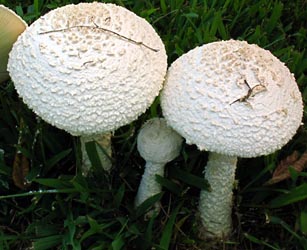
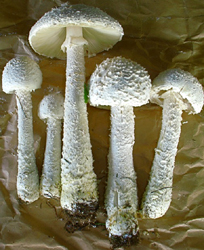

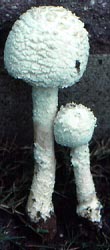

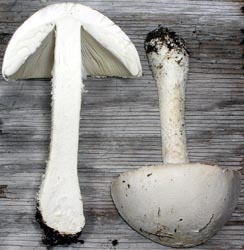
Technical description (t.b.d.)
Developing news about A. thiersii from the Pringle Lab
BRIEF DESCRIPTION: The cap of A. theirsii is 35 - 100 mm wide, convex to conico-convex to plano-convex, mostly with a low, broad umbo, white, dry, sometimes slightly viscid with age, with a non sulcate, appendiculate margin; cap flesh up to 10 mm thick. At first the cap is entirely covered by soft, subpulverulent, lanose-floccose, squamulose, white volva; later becoming more or less glabrous with scattered, floccose-fibrillose to felted, patch- or scale-like, at center sometimes wart-like remnants of volva.
The gills are crowded to subdistant, free, rather narrow to broad. In mass they appear white to yellowish to creamy yellow or yellowish cream. In side view they are white to cream to yellowish cream to sometimes almost color of egg yolk (in early stages of expansion). The short gills are attenuate to subattenuated to subtruncate to rounded-truncate, of many lengths, unevenly distriubted, and rather common to plentiful.
The stem is 80 - 200 x 10 - 20 mm, equal, stuffed to hollow, white, bruising yellow in some specimens (associated with yellowing in other parts of the fruiting body and an odor of cheese). The bulb is merely a slight broadening of the stipe base, e.g., 25 x 22 mm. At first, below the ring is densely covered by lanose-squamulose volva, with age breaking into easily removable, incomplete, floccose-squamose girdles, finally becoming scanty flocculose-squamulose to merely fibrillose.
Spores of A. thiersii measure (7.3-) 7.8 - 9.8 (-11.0) x (7.0-) 7.3 - 9.0 (-10.0) Ám and are globose to subglobose (rarely broadly ellipsoid) and amyloid. Clamps are absent from bases of basidia.
There is a plausible report of a case of serious POISONING attributed to this species, from the state of Puebla, Mexico (Tulloss, unpub.data). As far as I know the outcome of the poisoning is unknown. Given other recent poisonings by taxa of section Lepidella, one might expect A. thiersii to halt kidney function at least temporarily when ingested by humans. A Wieland [Meixner] test on the material involved in the cited poisoning case was negative for amatoxins. More information on poisoning by A. thiersii and other amanitas of subsection Vittadiniae is desired by the editors of these pages.
Specimens with yellow bruising reactions and/or an odor of cheese may be infected by one or more hyphomycetes as has been noted in other taxa such as A. subsolitaria (Murrill) Murrill and A. polypyramis (Berk. & Curt.) Sacc.
The species is found in grassy areas distant from trees, such as in lawns and public parks. It is known from Indiana, Illinois and Kansas, U.S.A. to the state of Puebla, Mexico.
Bas created stirps Thiersii in which the present species is placed along with A. albofloccosa A. V. Sathe & S. D. Deshp. (SW India), A. aureofloccosa Bas (Republic of Congo), A. foetens Singer (Argentina), and A. praeclara (Pearson) Bas (South Africa).
Developing news: Recent work in the Pringle Lab (Harvard Univ.) has provided DNA-based support for the morphologically-based hypothesis of C. Bas (1969) that species of subsect. Vittadiniae (like A. thiersii were taxa with few "evolved" or "derived" characters (as was said in the 1960's). This has been done by showing that, based on those segments of genetic material that have been sequenced to date, the so-called "least derived" taxa form a group with one or a few ancestors that came into existence very early in the evolution of the genus Amanita. This research is still on-going.
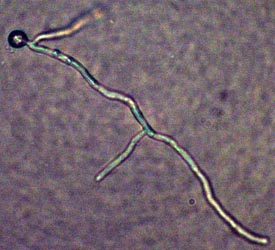 The same research group, with much of the research in the hands of Benjamin Wolfe, also carried out a number of experiments
demonstrating that indeed many of the basal taxa are at least capable of living as saprobes. Some species (the number is not yet known)
operate only as saprobes. Among these latter is Amanita thiersii. The picture at the head of this paragraph shows a spore of A. thiersii
germinating in the laboratory. Wolfe and Pringle have reported that A. thiersii can be grown easily in culture
and can live entirely on cellulose in culture.
The same research group, with much of the research in the hands of Benjamin Wolfe, also carried out a number of experiments
demonstrating that indeed many of the basal taxa are at least capable of living as saprobes. Some species (the number is not yet known)
operate only as saprobes. Among these latter is Amanita thiersii. The picture at the head of this paragraph shows a spore of A. thiersii
germinating in the laboratory. Wolfe and Pringle have reported that A. thiersii can be grown easily in culture
and can live entirely on cellulose in culture.
In 2009, a grant was sought and received by the Pringle Lab that will result in the sequencing of the entire genome of A. thiersii. Among the goals of having a complete genome for the present species is the study of the origin of ectomycorrhizal symbiosis in Amanita. The genus Amanita is segregated from all other agarics by the process of development of its fruiting bodies from tiny primordia. DNA evidence suggests with high confidence, that the genus is descendant from a single ancestor. This isolated group has, preserved within its present day boundaries, a diverse set of taxa (particularly in sect. Lepidella) that may serve as "genetic snap shots" of one evolutionary history of an ectomycorrhizal "life style." -- R. E. Tulloss
Photos: George M. Sayers (rows 1 through 3, Kansas)
Photo: Dr. Jay Justice (4th row leftmost, Arkansas)
Photos: R. E. Tulloss (4th row, remainder, Kansas)
Photo: Used with permission of the Pringle Lab, Harvard Univ. (within text, in vitro)
[ Section Lepidella page. ]
[ Amanita Studies home. ]
[ Keys & Checklist/Picturebooks ]
[ E. Texas & Gulf Coast list ]
Last change 9 October 2009.
This page is maintained by R. E. Tulloss.
Copyright 2003, 2004, 2006, 2009 by Rodham E. Tulloss.
Photograph copyright 2003 by Dr. Jay Justice.
Photographs copyright 2008 by Dr. R. E. Tulloss
Photographs copyright 2009 by George M. Sayers
Photograph from Pringle Lab: please
contact the lab regarding use.